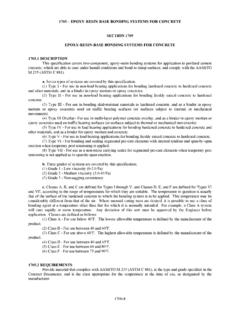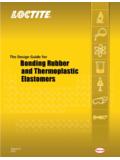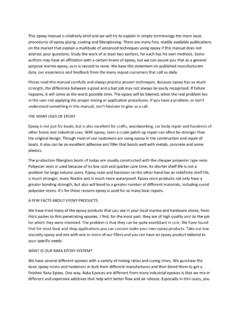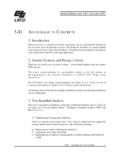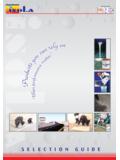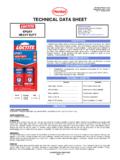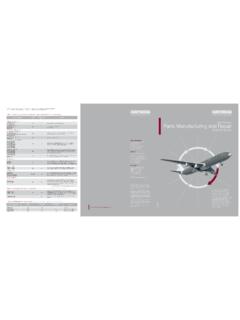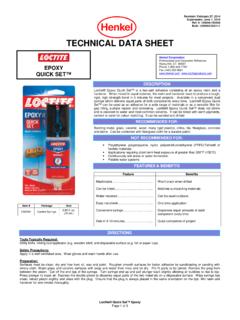Transcription of the resicon range - chemical and steel anchor systems for ...
1 The resicon rangechemical anchoring for industrywelcome to the resicon range of chemical anchor systems for heavy duty anchoring in masonry and concrete. our resins are manufactured in Europe to ISO 9001 standards using only the highest quality materials and using the latest blending, formulation and batch testing technology to ensure consistent high load is sold worldwide throughout the construction and civil engineering industries andis regularly specifi ed by architects and structural engineers for load critical structural applications and high profi le domestic and international hope you fi nd our chemical anchor catalogue informative.
2 Our sales and technical departments are always available for general advice and to answer any queries you may have about chemical anchoring and the resicon range . for more information about our company and details of our complete fi xings range please visit our : +44 (0) f : +44 (0) e : sales@constructionfi technical@constructionfi : anchoring welcome to the resicon range contentswww: constructionf anchoring 1 - 49 - 1213 - 1617 - 1819 - 2223 - 3031 - 325 - 8technical information introduction to chemical anchoringresicon3 epoxy acrylate injection resin styrene free resicon5 pure epoxy injection resin resicon7 polyester pourable resin resicon si epoxy acrylate spin-in glass capsules resicon2 polyester injection resin styrene free resicon accessories installation accessoriesresicon fi xings steel fi xings for use with resicon resinst : +44 (0) 121 506 6300technical information1www: constructionf anchoring t.
3 +44 (0) 121 506 6300what are chemical anchors :In simple terms, chemical or resin anchors are generic descriptions relating to steel studs, bolts or fi xings which are bonded into a substrate, usually masonry and concrete, using a resin based adhesive system . Ideally suited for high load applications, in virtually all cases the resulting bond is stronger than the base material itself and as the system is based on chemical adhesion, no load stress is imparted to the base material as with expansion type anchors. All systems operate using the same principle with the base resin requiring the introduction, by mixing, of a second component to begin the chemical curing process, hence the term chemical anchor .
4 Not all resins are the same and there are many different systems available in the market using a wide range of delivery systems and although all systems operate on the same basic principle, there are several differing blend formulations and chemical components usually designed by the manufacturer for specifi c performance criteria in differing applications and substrates high strength, low shrink, solvent free, high temperature, fast and slow cure etc. resin formulations :There are 2 basic resin families, catalytic and non-catalytic, the difference being catalytic resins use a 2 component resin and catalyst at ratios of approximately 10:1 and it is this catalyst that initiates the curing process.
5 The chemical reaction of the 2 components when mixed propagates throughout the mix as long as the base resin is in contact with any amount of the catalyst, the advantages of these resins are that mix proportions are not critical and they are generally less expensive due to the lesser amounts of catalyst required per mix volume. Catalytic resins for chemical anchoring are again broken down into several types such as polyester, vinylester, epoxy acrylate and methacrylate etc. dependant on the manufacturers formulation, all offer differing advantages and performance, for the resicon range we use polyester and epoxy acrylate with epoxy acrylate being the highest performer of the two for strength, durability and load resins, generally mixed in 1.
6 1 ratios, cure only when equal amounts of the 2 components are in direct contact and the chemical reaction does not spread throughout the mix as with catalytic resins, they are generally therefore only supplied as an injection system as this automatically dispenses the correct amount of each component into the mixing nozzle ensuring a thorough controlled mix has occurred prior to injection. Pure epoxy resin is the only non-catalytic resin currently in use for chemical anchoring. Epoxy resins cure slower than catalytic resins, however generally have superior mechanical and adhesive properties allowing higher loading and a stronger bond, epoxy is also virtually 100% non shrink and is therefore more suitable for larger holes and is generally (certainly for resicon5)
7 Suitable for underwater applications due to its water impervious cartridge systems are the most widely used format and consist of 2 resin components in separate compartments of a cartridge which mix proportionally in the supplied nozzle when pumped using the specifi c applicator gun for each type, this is a very versatile delivery system as more or less resin may be applied per anchor dependant on the application and it can be used with variable types and sizes of anchor bolts and fi xings, the resulting non sag mix makes this system the preferred choice for horizontal and overhead installations and perforated and hollow capsule systems consist of a resin, a quartz sand aggregate and a catalyst (in a secondary vial) all metered and factory sealed in a glass capsule for mixing in the hole with a specifi c anchor stud, the stud is driven through the capsule using a drilling machine, smashing the glass which then also forms part of the aggregate.
8 Glass capsule systems provide high bond strengths due in part to the larger aggregate size in comparison to the fi ner aggregates used for injection systems and they are a simple cost effective method of chemical anchoring. Glass capsule systems are generally viscous in nature, prior to mixing, and can be unsuitable for overhead installations and hollow masonry. Free mix systems are usually of the pourable type and consist of 2 separately packaged components for mixing on site either by hand or by machine using a mixing paddle. These systems are generally used where large deep holes require volume fi lling and where injection systems would be uneconomical or diffi cult to use, the system is also useful for bonding ir-regular shapes to or in concrete and masonry such as columns, ballustrades, assemblies and baseplates.
9 Specifi c care must be taken with this type of system to ensure the components are mixed in the correct volumes, due to the viscous nature they are generally only used for vertical downward holes. chemical anchor formats :installing chemical anchors :All types of resin anchors rely on a structural surface contact bond between both the anchor rod and resin and the resin and the drill hole wall, resins will only bond to the dust particles on the side walls and base of a drillhole and not the main substrate in poorly prepared holes. It is therefore vital that holes are thoroughly cleaned by blowing out and brushing prior to anchor installation.
10 Hole diameters and depths should also be clearly observed depending on the resin system used and installation guidelines should be strictly adhered : chemical anchoring is an extremely versatile and adaptive method of providing high load structural connections with very few failures. From historical testing and site inspection we have established without doubt that the single most common cause of anchor failures are poor hole preparation and cleaning. Other less common failures include incorrect hole diameters, use of out of date material and lack of observation of cure times.



